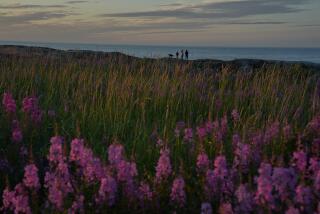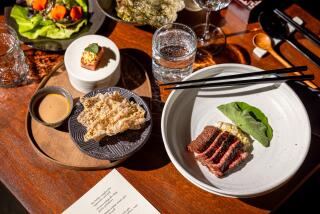Frontier Town : Sourdoughs Give Way to Bureaucrats
- Share via
YELLOWKNIFE, Canada — A bunch of the boys were whooping it up down at the Flat Base Cafe the other day, sipping cappuccino and nibbling croissants.
The prospectors who founded this town in the Northwest Territories 51 years ago as a gold camp might swallow their tobacco in disbelief, but plant-filled restaurants, foreign films, opera and boutiques are now as much a part of Yellowknife as the caribou steaks and booze usually associated with life on the Canadian frontier. Perhaps more so.
For sure, the people who sup on imported cheese and Chablis--before watching a European art movie--have more in common with a West Los Angeles film buff than with the characters of poet Robert W. Service, who filtered their rotgut whiskey through their chewing tobacco.
And the customer at the Flat Base Cafe, in his Burberry trenchcoat, having a cappuccino and cognac after his croissant-and-omelet lunch, is about as far removed from the old Northwest Territories as a Patagonian Indian is from Beverly Hills.
Full House for Operas
Yes, in this often-frozen land--where the sun doesn’t show for months on end, where ravens are the size of eagles, black flies attack like bumblebees and the nearest university is 450 miles away--operas and symphony concerts are sold out at the new arts and culture center.
People line up at “The Other Place” to sit under palm fronds and spider plants and dine on French cuisine, or to pay $7 for quiche at the MacKenzie Lounge. The grocer stocks kiwi fruit.
The question is obvious: How did this old tent city of gold seekers get transformed into a place where even the Wildcat Cafe, the only eatery dating back to Yellowknife’s beginnings, serves blintzes and eggs Benedict?
The answer is just as obvious: bureaucrats. For Canada is a country where the government is one of the major providers of jobs. In fact, nearly every Northwest Territories town of any size owes its existence to government.
Population Quadrupled
So, in 1967, the bureaucrats who ran the enormous but largely empty Northwest Territories from the federal capital at Ottawa, more than 3,000 miles away, began moving into Yellowknife, which was then a village of 3,000 people.
Yellowknife became the territorial capital. And as government replaced the gold mines as the major employer, the town grew, fast. Now there are about 12,000 people living on the shores of Great Slave Lake, and more than 3,000 of them work directly for the government, compared with 900 at the two working mines.
Most of the population has come from somewhere else and the people have brought with them the tastes and life styles of the metropolitan areas “south of 60,” as that part of Canada below 60 degrees latitude is known.
Women go to the office or to dinner in dresses designed in Paris and Montreal and bought at the Rhubarb Patch Boutique. They have their hair styled at the Scissor Shack and their makeup custom-applied by Eva of Europe.
It was not always that way, of course. Until 1934, there was nothing here but a few Dene Indians, along with the mosquitoes and black flies that afflict much of the Canadian North, and ravens, birds so large that Edgar Allen Poe might not have been able to fit them into his poetry.
Gold was found nearby before the turn of the century, but the cost of digging it out was so high that miners passed over this region for the famous Klondike fields.
Then, in 1933 and 1934, new finds brought in C.J. (Jack) Baker and H. M. Muir, who staked 24 claims. Yellowknife was born. Two big mines went into production and the first gold brick was poured in 1938. By 1940, seven mines were being worked.
8-Month Freeze
Life was rough. In the brief summer, people could get into Yellowknife only by boat and float plane. The lake was frozen for nearly eight months of the year and this led to the creation of ice trains--tractors pulling huge sleds across the frozen surface.
The first schoolteacher came in 1939, and a doctor shortly afterward. By 1940, there was a rough hotel and three restaurants.
Also, there were several illegal bars and a poker game upstairs over the Rex Cafe. The game is said to have gone on 24 hours a day, with the deputy constable raiding it only when his boss was not at the table.
The hard-drinking, brawling nature of the village began to change in the early 1940s, not because of any civilizing influence but because World War II drained Yellowknife of its men. The area went into decline.
With peace came new gold finds and more people, and the transformation began: the town progressed from separate collections of camps clinging to the mine sites to a unified community.
‘Great Place’ for Kids
“It was a great place to be a kid,” Mayor Don Sian, who was born here in 1948, said the other day, “a friendly, typical mining community.”
But according to Robert Pilot, a former Royal Canadian mounted policeman who is now deputy minister of the territorial Executive Council, “it was a pretty rough place, with lots of characters.”
“You were disappointed,” he said, “if there weren’t at least two fights (a night) in the lobby of the Yellowknife Inn.”
Even now, even with the boutique food and waitresses dressed like hostesses in Las Vegas, some of the old Yellowknife still lives.
There is “Old Margaret,” a 39-year-old derelict who sits outside the post office with a shopping basket and a battery-powered radio. She asks for handouts and threatens to punch anyone who gives her any back talk. Pilot, the deputy minister, says he once saw her beat a man until he begged her to stop.
Swapping Tales
And the old ways are found in the Miners’ Mess, a dingy hall where the old-timers gather to drink coffee and smoke and swap tales about the old days, when it was always colder, darker and better.
Although summers are moderate, the black flies, the mosquitoes and other swarming insects make it unpleasant. And winter gives a new meaning to the word cold. The temperature falls to 40 below zero and stays there. Parking lots are equipped with electrical outlets so that motorists can plug in the engine-block heaters on their cars. Eyebrows freeze.
And if the bureaucrats with their white collars and wine to match have changed the character of Yellowknife, the place’s geography and climate have combined to change the bureaucrat, too. After work and on weekends, the neckties and dressy clothes disappear and out come the baseball caps, the jeans and boots that make up the uniform of the territories.
Everyone a Fisherman
The streets are filled with pickup trucks and four-wheel-drive cars, all manner of rough-terrain vehicles, many of them with canoes on top. Hunting and fishing are nearly everyone’s hobbies, rivaled only by hockey and curling.
Still, when it comes down to it, this is about as much a frontier town as Santa Monica, particularly if you judge by the prices. A one-bedroom apartment rents for $850 a month; a small house, $1,800. If you want to buy, figure on paying $125,000 and up.
The town’s symbols may be the polar bear and the gold mining knife that inspired the name, but what really defines Yellowknife these days are the lines of smartly dressed people waiting to get into The Other Place for crepes.
More to Read
Sign up for Essential California
The most important California stories and recommendations in your inbox every morning.
You may occasionally receive promotional content from the Los Angeles Times.













